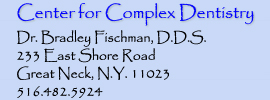 |
 |
In a study of dental casts on 154 TMD patients and 120 control subjects, Drs. John, Frank, Lobbezoo, Drangsholt, and Dette, (J Prosth Dent 2002;87:197-203) demonstrated that incisal tooth wear (assessed on dental casts) was not significantly associated with TMD when the influences of age and gender were controlled. Based on these findings, a clinically relevant risk for TMD from incisal tooth wear was not demonstrated. There is no evidence based on this study, to support the need for the restoration of incisal wear to prevent TMD. If this type of tooth wear is indicative of bruxism, then there is no indication that this type of bruxism is a clinically meaningful cause of TMD.
If this study holds true, then the reverse logic may also prove true. That is, restoration of points of contact in excursions on asymptomatic patients with worn occlusions, may be inappropriate treatment. This could result in increased bruxism and be a possible cause for TMD in the previously symptom free patient. Small restorations would seem to be even more significant in this scenario than large ones. Give it some thought.
 |
| Fig 1. Modified assesment for determination of incisal tooth wear severity according to Pullinger and sligman (modification in italics). 0=no visible tooth wear; 1=minimal wear of cusps or incisal tips (enamel); 2=facets parallel to normal planes of contour (enamel); 4=total loss of contour and dentin exposure when identifiable (dentin exposure up to half of former crown of tooth); 5=total loss of contour and dentin exposure over half of former crown of tooth. |
Dentures | Extreme Makeovers | Doctor's Credentials | Map & Policies | Contact Us
Home | Professional Referrals | Tidbits for Dentists | Newsletters for MDs